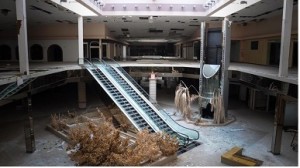shopping mall
The Shopping Mall
Vocabulary
| bazaar | hang out | landscape |
| enclose | structure | follow suit |
| hub | envision | enthusiast |
| clinic | cluster | settlement |
| pipe (2) | grandiose | pipe dream |
| slam | break (3) | mushroom (2) |
| push | abandon | consultant |
| mighty | throne | take their toll |
| decline | combine | recession |
| spree | notably | saturation |
| upscale | renovate | approximately |
| thrive | excess | leisure time |
| hollow | retailer | hollow out |
The Shopping Mall
Born in the 1950s, shopping malls have long been a part of the American landscape. It became a place to meet friends and hang out as well as to shop.
And the rest of the world has followed suit.
History of Shopping Malls
There had, of course, been market centers throughout history, among them Trajan’s Market in Ancient Rome and the bazaars of Baghdad, Istanbul, Isfahan and Changan.
The modern US shopping malls are fully enclosed structures serviced by cars and buses.
Victor Gruen
Mall enthusiasts can thank Victor Gruen. Born and trained as architect in Vienna, he moved to New York in 1938.
Gruen went on to design the world’s first modern shopping mall, the Southdale Center, which opened in 1956, in Edina, Minnesota.
The Vision
A lifelong socialist, Gruen envisioned shopping malls as forming a hub around which new settlements would cluster, complete with apartments, clinics and schools.
While his vision remained a pipe dream, malls themselves began mushrooming all across the US. Over the years, malls became more grandiose and stylish.
The Peak
By the mid-1990s, shopping malls in the US were being built at a rate of 140 a year.
Then the brakes were slammed in 2007.
It was the first year in half-a-century that no new malls were built in America.
Abandoned Malls
One by one, malls from California to Massachusetts began closing down. Within 20 years, retail consultant Howard Davidowitz expects half of America’s shopping malls go out of business.
Now you can find over a hundred abandoned malls from California to Massachusetts.

But how did this come about? What is pushing the mighty shopping mall off its throne?
Changes
Economic recession and industrial decline in certain areas − notably the mid-West − combined with the rise of online shopping and market saturation have taken their toll.
Most failed malls were the excess of the mall building spree.
Today, the largest malls are outside the US, in countries such as China, Indonesia, Malaysia, the Philippines, and even Bangladesh and Iran.
Continued Success
This does not spell the end for shopping malls in America.
Of the approximately 1,000 malls, about 400 are upscale. These are thriving. They are being renovated and extended. People still spend their leisure time there.
It’s 600 middle and lower-end malls that are facing hard times and closure.
Ghost Malls
What will become of these hollowed-out “ghost malls”?
They will probably eventually be filled with other enterprises: business offices, medical clinics, theaters, restaurants and discount retailers.
Questions
1. People only shop in shopping malls. Is this true or false?
2. Are shopping malls entirely new and modern? What is the main difference between ancient markets and modern malls?
3. Who was the “father of the shopping mall”? What was his vision? Has it come true?
4. What happened between 1956 and 2007? What happened after 2007?
5. Why did this happen?
6. The same thing is happening in the rest of the world. Is this correct or wrong?
7. The shopping mall will completely disappear from the US. What do you think?
A. How many shopping malls are in your city or near your home?
B. I love shopping malls! I like to shop and hang around shopping malls with my friends. Yes or no?
C. Are shopping malls very popular? Are they part of modern culture?
D. Are more shopping malls being built in your region or province or country? Are they getting bigger? Or are they becoming less popular?
E. What will happen in the future?

